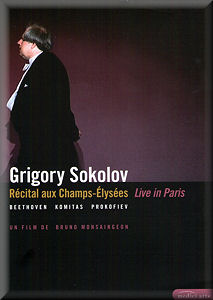 |
 |
|


MDT
AmazonUK
AmazonUS
|
Grigory Sokolov - Live in Paris
Ludwig van BEETHOVEN (1770-1827)
Piano Sonatas: No. 9 in E, Op. 14/1 (1798) [15:00]; No. 10 in G,
Op. 14/2 (1799) [15:30]; No. 15 in D, Op. 28, “Pastorale” (1801)
[29:09]
KOMITAS (1869-1935)
Six Dances [21:53]
Sergei PROKOFIEV (1891-1953)
Piano Sonata No. 7 in B flat, Op. 83 (1942) [21:29].
Encores
Frédéric CHOPIN (1810-1849)
Mazurkas – C sharp minor, Op. 63/3 [3:23]; F minor, Op. 68/4 [4:40].
François COUPERIN (1668-1733)
Le Tic-Toc Choc ou Les Maillotins [3:21]
Soeur Monique [4:01]
Johann Sebastian BACH (1685-1750)
Prelude in B minor (after BWV855a, arr. Siloti) [2:49]
 Grigory Sokolov (piano)
Grigory Sokolov (piano)
rec. live, Théâtre des Champs-Elysées, 4 November 2002
 MEDICI ARTS 3073888 [123:02]
MEDICI ARTS 3073888 [123:02] 

|
|
|
This is a rare opportunity to savour the art of Grigory Sokolov,
that most reclusive of pianists. A Barbican
recital in May 2006 furnished the only opportunity I personally
have had of hearing him – and what a revelation it was, too.
The trio of Beethoven Sonatas is perfectly chosen: the Op. 14
set complements the Op. 28 perfectly. How many amateur pianists,
I wonder, have slaved over the E-Major from Op. 14, aiming at
full evenness in the interlocking third semiquavers in the first
movement and, like myself, failed miserably – at least in comparison
to Sokolov. There is an element of rescuing these sonatas from
an undeserved reputation as teaching pieces so that they can
take their rightful place as a part of the canon. Sokolov lavishes
much love on the first movement of the E-Major. The central
Allegretto movement of the sonata is no mere dashed-off interlude.
It, too, has care upon care heaped upon it, to revelatory effect.
Note the way Sokolov links the two-octave leaps between the
“E”s in a miraculous way, or the way his scales are things of
pearly, even beauty in the finale. The second sonata of the
pair, the G-Major, here holds a first movement of the utmost
burnished lyricism. Bruno Monsaingeon's camera angles, fully
entwined with the music itself, and Sokolov's beloved low lighting
highlight the sense of intimacy here. Sokolov's touch in the
central movement of the G-Major is infinitely varied, his depth
of sound entirely in keeping with his conception and used to
contrast with the most fantastical staccatos. Sokolov now takes
my first recommendation in these pieces - previously reserved
for Backhaus.
The serenity of Beethovenian D-Major pervades the first movement
of Sokolov's “Pastorale” sonata. The Andante is a lesson in
fine piano technique, with the wonderfully legato right hand
against perfectly judged left hand staccati resulting in a magnificent
Beethoven processional. Musicality is all here – it is only
in retrospect that one allows oneself the time to gawp at Sokolov's
even left hand in the third movement. At the time, one is completely
engrossed in Beethoven's fascinating musical surface. And that,
surely, is how it should be. The finale is slower than most
– more a recollection of shepherds piping than the pipes themselves.
Ashkenazy in his early Decca account was most definitely in
the opposing latter camp, for example. The coda is stunning,
and, for once, not a mad romp to the finishing line.
The cheers that greet Sokolov after the final Beethoven Sonata
are more those that one would associate with end of recital
delirium. Quite rightly, though. This is Beethoven playing of
the very first rank. Every note, every phrase is to be cherished.
Not only that, Sokolov's realisation of and delineation of musical
structure is exemplary and he is one of the few musicians that
can marry that to exquisite surface detail.
The three Beethoven Sonatas provided the first half of the recital
and were given without a break for applause. The second part
opened with the Komitas Dances, an idiosyncratic choice in which
Sokolov fully presented the inherent melancholy of these pieces
from Armenia. Close-up shots of Sokolov's face show his clear
involvement and concentration. The piano is perfectly tuned
– the overall result is mesmerising.
For the Prokofiev Seventh Sonata, it is Pollini who has for
long held my affections (DG). Sokolov matches Pollini in animalistic,
elemental ferocity but includes more moments of bitter-sweet
lyricism. Again, this reading goes to the top of my tree. Sokolov's
mastery of staccato comes into its own here. Note also how Monsaingeon's
use of a distant camera can emphasise the loneliness of this
music's slower portions. The intensity of the slow movement's
climax is monumental. If Sokolov does not quite equal Polini's
cumulative effect in the finale, it is a close thing indeed.
The standing ovation is no surprise – neither is the quantity
and quality of the encores. The Chopin Mazurkas actually sandwich
the Couperin items. Sokolov's Chopin is twilit magic, his Couperin
a ray of adroitly-turned daylight. The final encore is a Bach/Siloti
Prelude. Sokolov's articulation is perfectly clean, but it is
the serenity that makes the performance glow that is most memorable.
The perfect way to end.
Colin Clarke
|
|

